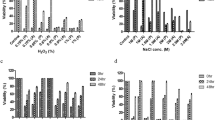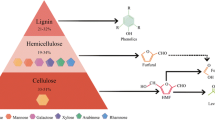Abstract
An effective, simple, and convenient method to improve yeast’s multiple-stress tolerance, and ethanol production was developed. After an ethanologenic Saccharomyces cerevisiae strain SC521 was treated by nine cycles of freeze-thaw, a mutant FT9-11 strain with higher multiple-stress tolerance was isolated, whose viabilities under acetic acid, ethanol, freeze-thaw, H2O2, and heat-shock stresses were, respectively, 23-, 26-, 10- and 7-fold more than the parent strain at an initial value 2 × 107 c.f.u. per ml. Ethanol production of FT9-11 was similar (91.5 g ethanol l−1) to SC521 at 30°C with 200 g glucose l−1, and was better than the parent strain at 37°C (72.5 g ethanol l−1), with 300 (111 g ethanol l−1) or with 400 (85 g ethanol l−1) g glucose l−1.



Similar content being viewed by others

References
Alexandre H, Ansanay-Galeote V, Dequin S, Blondin B (2001) Global gene expression during short-term ethanol stress in Saccharomyces cerevisiae. FEBS Lett 498:98–103
Ames BN, Shigenaga MK, Hagen TM (1993) Oxidants, antioxidants, and the degenerative diseases of aging. Proc Natl Acad Sci 90:7915–7922
Ando A, Tanaka F, Murata Y, Takagi H, Shima J (2006) Identification and classification of genes required for tolerance to high-sucrose stress revealed by genome-wide screening of Saccharomyces cerevisiae. FEMS Yeast Res 6:249–267
Attfield PV (1997) Stress tolerance: The key to effective strains of industrial baker’s yeast. Nature Biotechnol 15:1351–1357
Benaroudj N, Lee DH, Goldberg AL (2001) Trehalose accumulation during cellular stress protects cells and cellular proteins from damage by oxygen radicals. J Biol Chem 276:24261–24267
Cakar ZP, Seker UOS, Tamerler C, Sonderegger M, Sauer U (2005) Evolutionary engineering of multiple-stress resistant Saccharomyces cerevisiae. FEMS Yeast Res 5:569–578
Davidson JF, Whyte B, Bissinger PH, Schiestl RH (1996) Oxidative stress is involved in heat-induced cell death in Saccharomyces cerevisiae. Proc Natl Acad Sci 93:5116–5121
Du X, Takagi H (2005) N-Acetyltransferase Mpr1 confers freeze tolerance on Saccharomyces cerevisiae by reducing reactive oxygen species. J Biochem 138:391–397
Giudici P, Solieri L, Pulvirenti AM, Cassanelli S (2005) Strategies and perspectives for genetic improvement of wine yeasts. Appl Microbiol Biotechnol 66:622–628
Herdeiro RS, Pereira MD, Panek AD, Eleutherio ECA (2006) Trehalose protects Saccharomyces cerevisiae from lipid peroxidation during oxidative stress. Biochim Biophys Acta 1760:340–346
Hermes-Lima M, Storey KB (1993) Antioxidant defenses in the tolerance of freezing and anoxia by garter snakes. Am J Physiol 265:646–652
Lewis JG, Learmonth RP, Watson K (1993) The role of growth phase and ethanol in freeze-thaw stress resistance of Saccharomyces cerevisiae. Appl Environ Microbiol 59:1065–1071
Longo VD, Lion LL, Valentine JS, Gralla EB (1999) Mitochondrial superoxide decreases yeast survival in stationary phase. Arch Biochem Biophys 365:131–142
Lucero P, Pen-Alver E, Moreno E, Lagunas R (2000) Internal trehalose protects endocytosis from inhibition by ethanol in Saccharomyces cerevisiae. Appl Environ Microbiol 66:4456–4461
Morris GJ, Coulson GE, Clarke KJ (1988) Freezing injury in Saccharomyces cerevisiae. The effects of growth conditions. Cryobiology 25:471–472
Park JI, Grant CM, Attfield PA, Dawes IW (1997) The freeze-thaw stress response of the yeast Saccharomyces cerevisiae is growth phase specific and is controlled by nutritional state via the RAS-cyclic AMP signal transduction pathway. Appl Environ Microbiol 63:3818–3824
Park JI, Grant CM, Davies MJ, Dawes IW (1998) The cytoplasmic Cu, Zn superoxide Dismutase of Saccharomyces cerevisiae is required for resistance to freeze-thaw stress. J Boil Chem 273:22921–22928
Rodriguez-Vargas S, Sanchez-Garcia A, Martinez-Rivas JM, Prieto JA, Randez-Gil F (2007) Fluidization of Membrane lipids enhances tolerance of freezing and salt stress by Saccharomyces cerevisiae. Appl Environ Microbiol 73:110–116
Rossignol T, Dulau L, Julien A, Blondin B (2003) Genome-wide monitoring of wine yeast gene expression during alcoholic fermentation. Yeast 20:1369–1385
Teunissen A, Dumortier F, Gorwa M, Bauer J, Tanghe A, Loïez A, Smet P, Dijck PV, Thevelein JM (2002) Isolation and characterization of a freeze-tolerant diploid derivative of an industrial baker’s yeast Strain and its use in frozen doughs. Appl Environ Microbiol 68:4780–4787
Van Dijck P, Gorwa MF, Lemaire K, Teunissen A, Versele M, Colombo S, Dumortier F, Ma P, Tanghe A, Loiez A, Thevelein JM (2000) Characterization of a new set of mutants deficient in fermentation-induced loss of stress resistance for use in frozen dough applications. Int J Food Microbiol 55:187–192
Versele M, Thevelein JM, Van Dijck P (2004) The high general stress resistance of the Saccharomyces cerevisiae fil1 adenylate cyclase mutant (Cyr1Lys1682) is only partially dependent on trehalose, Hsp104 and overexpression of Msn2/4-regulated genes. Yeast 21:75–86
Verstrepen KJ, Iserentant D, Malcorps P, Derdelinckx G, Van Dijck P, Winderickx J, Pretorius IS, Thevelein JM, Delvaux FR (2004) Glucose and sucrose: hazardous fast-food for industrial yeast? Trends Biotechnol 22:531–537
Acknowledgements
This study was supported by the National Basic Research Program of China (No 2004 CB719702) and the National Knowledge Innovation Project of the Chinese Academy of Sciences.
Author information
Authors and Affiliations
Corresponding author
Rights and permissions
About this article
Cite this article
Wei, P., Li, Z., Lin, Y. et al. Improvement of the multiple-stress tolerance of an ethanologenic Saccharomyces cerevisiae strain by freeze-thaw treatment. Biotechnol Lett 29, 1501–1508 (2007). https://doi.org/10.1007/s10529-007-9419-1
Received:
Revised:
Accepted:
Published:
Issue Date:
DOI: https://doi.org/10.1007/s10529-007-9419-1



